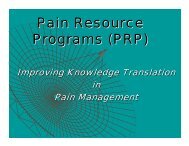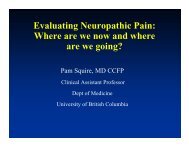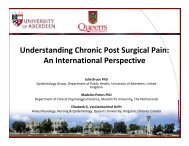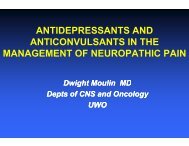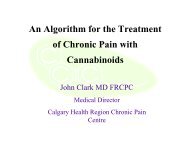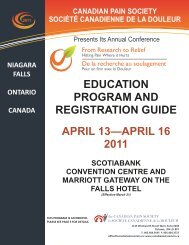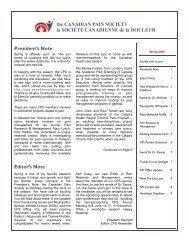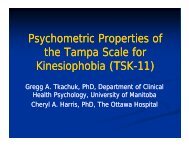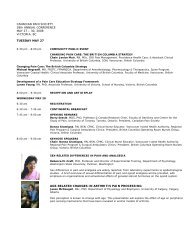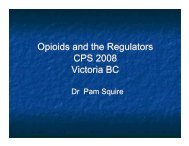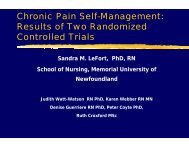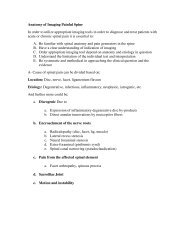Stigma in Children and Adolescents with Chronic Pain
Stigma in Children and Adolescents with Chronic Pain
Stigma in Children and Adolescents with Chronic Pain
- No tags were found...
Create successful ePaper yourself
Turn your PDF publications into a flip-book with our unique Google optimized e-Paper software.
Acknowledgements• Dr. Pravesh Vallabh• Alex<strong>and</strong>er Baloukov• Michelle Verrier• Dr. Patricia Reed, Doctoral Dissertation
Overview• Factors associated <strong>with</strong> stigma• <strong>Stigma</strong> <strong>in</strong> adults <strong>with</strong> chronic pa<strong>in</strong>• Perceived stigma – CPSS• <strong>Stigma</strong> <strong>in</strong> children <strong>and</strong> teens <strong>with</strong> chronic pa<strong>in</strong>• Development of the <strong>Children</strong>’s CPSS• What can we do?
• Goffman (1963):<strong>Stigma</strong>• “...reduces the stigmatized <strong>in</strong>dividual froma whole <strong>and</strong> usual person to a ta<strong>in</strong>ted,discounted one.”• <strong>Stigma</strong> orig<strong>in</strong>ates from ancient Greece• Body mark<strong>in</strong>gs were used to discredit themoral status of a marked person.• The blemished person was to be avoided.
<strong>Stigma</strong>• Lerner & Simmons (1966):• Just world hypothesis: people get whatthey deserve• Attribution theory (We<strong>in</strong>er, 1986)• Blame the victim• Decreases own anxiety• Increases sense of control that one canavoid a similar fate
Associated Factors• Depression (Fife & Wright, 2000)• Decreased self-esteem (Berger et al., 1998)• Stra<strong>in</strong>ed <strong>in</strong>terpersonal relationships (Govier etal., 1994)• Lower QOL (Asbr<strong>in</strong>g & Narvanen, 2002)• These factors can affect medicaloutcomes <strong>and</strong> illness adjustment
<strong>Stigma</strong> (Reed, 2005)• Level consistently affected by:• Attribution to psychological cause• Perceived controllability• Severity of illness• <strong>Chronic</strong> pa<strong>in</strong> <strong>in</strong>cludes all of the above• Labell<strong>in</strong>g by physicians po<strong>in</strong>ted to asstrong predictor of perceived stigma• Marbach et al. (1990)
Commonly <strong>Stigma</strong>tized Diagnoses• Fibromyalgia• Irritable Bowel Syndrome• Functional Abdom<strong>in</strong>al Pa<strong>in</strong>• Pa<strong>in</strong> Amplification Syndrome• <strong>Chronic</strong> Daily Headache• Anyth<strong>in</strong>g treated <strong>with</strong> opioids…• Pepp<strong>in</strong> (2009) / Gardner & S<strong>and</strong>hu (2007)
Åsbr<strong>in</strong>g & Närvänen (2002)• Fibromyalgia & <strong>Chronic</strong> Fatigue Syndrome• <strong>Stigma</strong>tization reported to be worse beforeformal diagnosis provided• Associated <strong>with</strong> question<strong>in</strong>g of honesty,morality <strong>and</strong> accuracy of person• Psychologiz<strong>in</strong>g of symptoms stigmatiz<strong>in</strong>g
The person’s experience• ‘It’s all <strong>in</strong> your head’• Common terms:• Non-organic, functional, psychosomatic,idiopathic• ‘Cl<strong>in</strong>ical diagnoses’• Many terms used pejoratively
Looper & Kirmayer (2004)• Compared perceived stigma <strong>in</strong>:• Functional SomaticSyndromes (FSS)• CFS• FM• IBSvs.• Validated medicaldiagnoses:• MS• RA• IBD• Higher perceived stigma <strong>in</strong> FSS
The face of stigma <strong>in</strong> chronic pa<strong>in</strong>• S/he can do X but not Y…• <strong>Children</strong> who keep play<strong>in</strong>g while report<strong>in</strong>ghigh levels of pa<strong>in</strong> (distraction)• Recreational activities, hobbies, family• ANY, even remote psychosocial eventsmay be l<strong>in</strong>ked to pa<strong>in</strong> syndrome
<strong>Stigma</strong> <strong>in</strong> adults <strong>with</strong> chronic pa<strong>in</strong>• Reed (2005)• <strong>Chronic</strong> Pa<strong>in</strong> <strong>Stigma</strong> Scale (CPSS)• 30-item Likert scale• 3 doma<strong>in</strong>s:• General public• Physicians• Family
<strong>Chronic</strong> Pa<strong>in</strong> <strong>Stigma</strong> Scale (CPSS)• Dimensions of chronic pa<strong>in</strong> stigma:• Estrangement• Attribution to psychological cause• Mal<strong>in</strong>ger<strong>in</strong>g• Bias aga<strong>in</strong>st opioid analgesics• General negative attitudes
<strong>Chronic</strong> Pa<strong>in</strong> <strong>Stigma</strong> Scale (CPSS)• N = 150 (62% male)• OA & LBP• Good <strong>in</strong>ternal consistency for entire scale<strong>and</strong> subscales• Good discrim<strong>in</strong>ant validity (compared tomeasure of impairment)• Moderate positive correlation <strong>with</strong>depression• Moderate negative correlation <strong>with</strong>QOL
<strong>Chronic</strong> Pa<strong>in</strong> <strong>Stigma</strong> Scale (CPSS)• 79% reported stigma due to pa<strong>in</strong>-relatedunemployment• 57% reported physicians believe chronicpa<strong>in</strong> mostly a mental/emotional problem• 49% reported perception that physicianswould prefer not to treat chronic pa<strong>in</strong>• 35% reported that family members respectthem less because of chronic pa<strong>in</strong>
<strong>Chronic</strong> Pa<strong>in</strong> <strong>Stigma</strong> Scale (CPSS)706050403020100Percent AgreementPublic Physician Family• High endorsement of stigma related to useof analgesics, especially opioids
<strong>Chronic</strong> Pa<strong>in</strong> <strong>Stigma</strong> Scale (CPSS)• Dr. Pravesh Vallabh• Explore level of perceived stigma <strong>in</strong> ourMultidiscipl<strong>in</strong>ary Pa<strong>in</strong> Centre• Does CBT reduce perceived stigma <strong>in</strong>adults <strong>with</strong> chronic pa<strong>in</strong>?• 3 experimental groups:1) Group CBT <strong>with</strong> no family member2) Group CBT <strong>with</strong> family member3) Wait-list control group
CPSS ScoreCPSS Prelim<strong>in</strong>ary data
CPSS Prelim<strong>in</strong>ary data• Anxiety associated <strong>with</strong> CPSS Full Score• r = .83, p = .021• Quality of life <strong>in</strong>versely related to CPSSFull Score• r = -.87, p = .012
<strong>Stigma</strong> <strong>in</strong> children <strong>and</strong> teens<strong>with</strong> chronic pa<strong>in</strong>• Pediatric stigma research less common <strong>in</strong>the literature• HIV/Aids (Yan, Xiao, Zhou, & Tang, 2008)• Epilepsy (Aust<strong>in</strong> et al., 2004)• Perceived stigma associated <strong>with</strong> poorer selfconcept<strong>and</strong> <strong>in</strong>creased depression• Obesity (Swaye Macdermott, 2008; Puhl & Latner, 2007)• Mental illness (Hanrahan, 2008; Perry et al., 2007)
<strong>Stigma</strong> <strong>in</strong> children <strong>and</strong> teens<strong>with</strong> chronic pa<strong>in</strong>• Dell’Api et al. (2007)• Negative outcomes often reported <strong>in</strong><strong>in</strong>teractions between children <strong>with</strong> chronicpa<strong>in</strong> <strong>and</strong> their physicians• Psychological causes often ascribed byphysicians when no organic causediscovered• Therapeutic alliance affected
<strong>Stigma</strong> <strong>in</strong> children <strong>and</strong> teens• Logan et al. (2007)<strong>with</strong> chronic pa<strong>in</strong>• Teacher’s perceptions of children <strong>with</strong>chronic pa<strong>in</strong>• Almost 2/3 of respondents held dualisticrather than biopsychosocial view• Increased sympathy when physical causefor pa<strong>in</strong> perceived
<strong>Stigma</strong> <strong>in</strong> children <strong>and</strong> teens <strong>with</strong>• Alex Baloukovchronic pa<strong>in</strong>• Prelim<strong>in</strong>ary validation of <strong>Children</strong>’s<strong>Chronic</strong> Pa<strong>in</strong> <strong>Stigma</strong> Scale• Language of items made ‘child friendly’• Added Teacher subscale
<strong>Stigma</strong> <strong>in</strong> children <strong>and</strong> teens<strong>with</strong> chronic pa<strong>in</strong>• Sample from Stollery Pediatric <strong>Chronic</strong> Pa<strong>in</strong>Cl<strong>in</strong>ic• MSK pa<strong>in</strong>, chronic headache, abdom<strong>in</strong>al pa<strong>in</strong>,CRPS, Fibromyalgia, various other dx.• Ages 11 – 17 years• Predom<strong>in</strong>antly adolescent females
Development of CCPSS• Demographics <strong>and</strong> medical history• Child Attitude Toward Illness Scale (CATIS)• Higher score = more positive attitude• <strong>Children</strong>’s Depression Inventory (CDI)• Multidimensional Anxiety Scale for <strong>Children</strong>(MASC)
CCPSS Prelim<strong>in</strong>ary data
CCPSS Prelim<strong>in</strong>ary data• Depression <strong>and</strong> anxiety not significantlycorrelated <strong>with</strong> CPSS Full Score• Attitude toward illness <strong>in</strong>versely related toCPSS Full Score• r = -.59, p = .047
Holloway et al. (2007)• <strong>Stigma</strong> from family, friends, public, healthproviders• People feel stigmatized by the time theyattend pa<strong>in</strong> cl<strong>in</strong>ics• This perception may affect attitudes <strong>and</strong><strong>in</strong>teractions <strong>with</strong> health care providers• Treatment programs need to address thisreality <strong>in</strong> a practical way
• Normalize lifeWhat can we do?• Encourage activities & hobbies• Educate ourselves <strong>and</strong> others• Support & Encourage• Cognitive <strong>and</strong> behavioural strategies tocope <strong>with</strong> stigma• Life Despite Pa<strong>in</strong> (program & philosophy)
Summary• Factors associated <strong>with</strong> stigma• <strong>Stigma</strong> <strong>in</strong> adults <strong>with</strong> chronic pa<strong>in</strong>• Perceived stigma – CPSS• <strong>Stigma</strong> <strong>in</strong> children <strong>and</strong> teens <strong>with</strong> chronic pa<strong>in</strong>• Development of the CCPSS - Perceivedstigma <strong>in</strong> children• How we can make a difference



